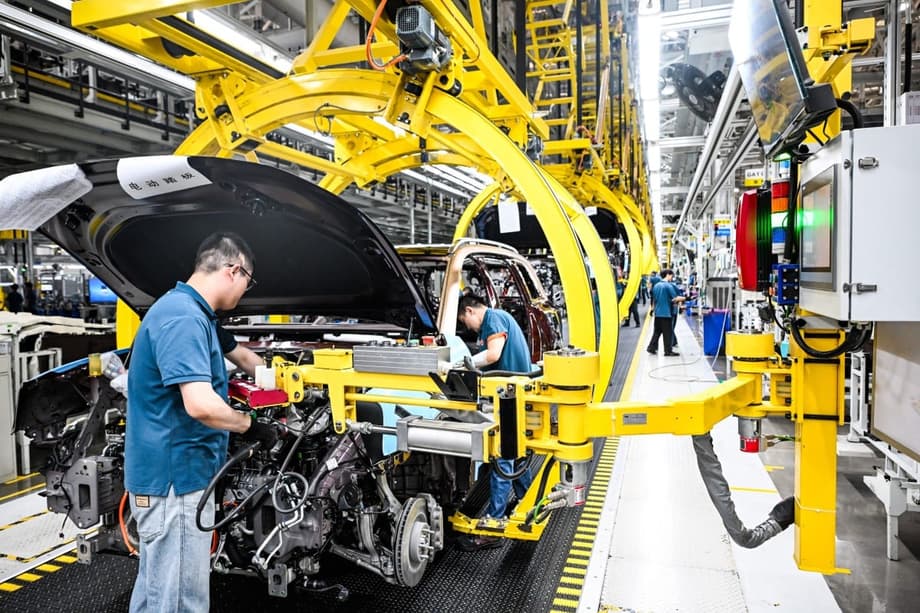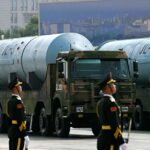Why manufacturing still matters for China
Beijing has put manufacturing at the heart of its next phase of development, signaling that the share of factories in the economy will be protected to ward off industrial hollowing out. Policymakers see manufacturing as a foundation for national strength and economic resilience. As countries grow richer, manufacturing usually peaks as a share of output then declines. China’s leaders are determined to manage that arc rather than let it manage them. The priority is to sustain a large and advanced industrial base while pushing companies up the value chain.
- Why manufacturing still matters for China
- What the 2026 to 2030 plan signals
- Can China avoid deindustrialization pressures seen elsewhere?
- Data check: where the factory sector stands
- The strategy mix: self reliance, AI, and a unified national market
- Risks around overcapacity, prices, and debt
- Global blowback and the search for choke point resilience
- What success looks like: upgrading, productivity, and better jobs
- What to watch next
- The Bottom Line
The stakes are high. China has been the world’s largest manufacturer for 15 straight years and is the only economy that covers every industrial category under the United Nations system. Manufacturing value added accounted for roughly a quarter of gross domestic product in 2024, about 24.9 percent, underscoring the sector’s central role in jobs, innovation, exports, and tax revenue. The leadership argues that in a populous and still developing country, a strong real economy relies on a strong factory network, from heavy equipment to precision components.
That view is laid out in an official guide to the coming 15th five year plan, which warns against complacency about the risks of deindustrialization.
In a book released by the Communist Party leadership that interprets priorities for 2026 to 2030, the authors set out the challenge bluntly.
“In recent years, some advanced economies have attempted to revive their manufacturing sectors after deindustrialisation, but it has proven to be extremely difficult,” the authors wrote.
What the 2026 to 2030 plan signals
The Party’s Central Committee has outlined a strategy to build a modern industrial system centered on advanced manufacturing and greater technological self reliance. The headline goals are to improve production quality, secure key supply chains, and push breakthroughs in core technologies. The plan emphasizes the need to maintain a reasonable share of manufacturing in the economy, though it stops short of setting a numerical target. Leaders also call for stronger domestic demand and higher living standards, but the primary engine remains production and investment.
This approach reflects a strategic choice. Trade tensions with major partners, tighter controls on advanced technologies, and national security concerns have reinforced the logic of a big and capable factory base. China’s leaders say they will sharpen competitive advantages in areas such as clean energy, electric vehicles, batteries, and industrial machinery while upgrading traditional sectors like steel, chemicals, and textiles through automation and digital tools. The aim is an industrial system that is more innovative, more productive, and more resilient to external shocks.
Can China avoid deindustrialization pressures seen elsewhere?
Many rich economies have struggled to reverse the loss of factories and skilled production jobs. Efforts to rebuild industrial capacity often run into cost hurdles, skills shortages, and fragmented supply chains. China seeks to avoid that fate by protecting the scale of its manufacturing while intensifying innovation. That stance does not mean resisting change. It means pushing factories to produce more complex goods, improve quality control, and anchor strategic technologies at home.
Officials and academics point out that this course has been a consistent theme for years. The current plan formalizes it for the next period and ties it to national security and long term prosperity. The approach fits with recent campaigns to localize core inputs, expand high end equipment production, and reduce dependence on foreign suppliers for critical parts.
Dong Yu, executive vice president of the China Institute for Development Planning at Tsinghua University, noted that this focus is not new, even if the language has sharpened.
“The 14th five year plan already has such a requirement,” Dong said, referring to preserving the share of manufacturing in the economy.
A second challenge is economic balance. Economists inside and outside China have urged a stronger pivot toward household consumption to correct structural imbalances. The leadership acknowledges this, yet the new framework still places manufacturing at the center, with domestic demand to be nurtured over time. Managing that tension is one of the defining tests of the next plan.
Data check: where the factory sector stands
The latest indicators show a manufacturing sector that remains vast, productive, and globally connected, but also uneven in momentum across subsectors. Growth in value added manufacturing was solid through 2024 and into 2025, while surveys of purchasing managers have hovered around the 50 percent line that separates expansion from contraction. Fixed asset investment in factories has continued to rise, a sign of confidence in long term capacity upgrades.
Key numbers at a glance
- Manufacturing accounted for about 24.86 percent of GDP in 2024, or roughly 33.55 trillion yuan in output.
- China has been the top global manufacturing country for 15 consecutive years, producing about 30 percent of world manufacturing added value.
- Manufacturing exports remain the backbone of foreign sales, representing more than 90 percent of total exports in 2024.
- Monthly value added growth in 2025 has ranged roughly between 5.7 and 7.9 percent.
- Fixed asset investment in manufacturing posted gains, with growth rates typically in the mid single to low double digits over 2024 and 2025.
- Foreign direct investment into manufacturing made up more than a quarter of total FDI in 2024, reflecting continued interest in Chinese supply chains, skilled labor, and infrastructure.
Behind the headline numbers is a map of more than 2,000 industrial clusters spread across eastern and central provinces, with new clusters rising in western and northern regions. Costs have climbed in many cities, especially for labor and land. Yet companies continue to invest to be close to suppliers, ports, and large domestic markets. Policy incentives, from tax preferences to research and development support, add to that calculus.
The strategy mix: self reliance, AI, and a unified national market
Beijing’s industrial policy has two broad thrusts. The first is to lift domestic capabilities in strategic technologies. The second is to raise productivity across the entire factory base. That means more research funding, closer links between universities and industry, and faster deployment of digital tools on factory floors.
China’s top industry regulator, the Ministry of Industry and Information Technology, is preparing a comprehensive AI plus manufacturing program to bring artificial intelligence into key production processes. The goal is to raise quality, lower costs, and improve energy efficiency by embedding data driven decision making in equipment, workflows, and maintenance routines. Authorities point to a large AI ecosystem, with thousands of firms and a growing base of specialized small and medium enterprises using machine vision, predictive analytics, and industrial software.
MIIT Minister Li Lecheng recently described how the government will guide this push and support enterprise adoption.
“We will establish a comprehensive policy framework to support the application of AI, including implementation guidelines for the AI plus Manufacturing plan,” Li said. “These policies will address intelligent transformation in key industries and critical processes, supported by an AI application guide for manufacturing enterprises.”
Fiscal policy is also being aligned with the industrial agenda. The Ministry of Finance has pledged to direct more resources to core technology breakthroughs, the transformation of traditional sectors, and the digital upgrade of smaller firms. The message is that innovation will be rewarded and bureaucratic hurdles will be reduced.
In a report on fiscal policy execution, the ministry emphasized a level playing field and more efficient use of science and technology funds.
“China will direct more fiscal resources towards industrial innovation, pursue breakthroughs in core technologies, and promote the transformation and upgrading of the manufacturing sector,” the ministry said. “Support for the digital transformation of small and medium sized enterprises will be increased, and a unified national market will be advanced to ensure equal treatment in fiscal subsidies and government procurement.”
This push fits with longer running industrial programs. The Made in China 2025 strategy, launched a decade ago, targeted domestic supplier strength in areas like information technology, robotics, aerospace, rail equipment, medical devices, and energy saving vehicles. The new plan inherits that ambition while updating the toolbox. Officials increasingly use the phrase new quality productive forces to capture the idea of combining fundamental scientific progress with industrial application and advanced manufacturing.
Risks around overcapacity, prices, and debt
Rapid expansions in capacity can bring growing pains. When many firms pile into promising sectors at once, competition intensifies and prices can fall faster than costs. This pattern has appeared in autos, solar, batteries, and some metals. Price wars compress profit margins even for market leaders, which can discourage private investment and strain corporate balance sheets. Low prices also ripple through global markets, raising the risk of trade friction with partners who view Chinese goods as underpriced.
Macroeconomic headwinds add to the challenge. A long property downturn has weighed on domestic demand and local government finances. Economists warn that high debt levels, roughly three times the size of the economy by some estimates, combined with low inflation, can make deleveraging more difficult. If profits remain thin across swathes of manufacturing, banks may face pressure from weak borrowers. Policymakers have tried to prevent sharp layoffs and factory closures that would hit incomes and social stability. The risk is that support for unproductive firms could slow the reallocation of capital toward more dynamic companies.
There are also international constraints. Export growth can offset weak domestic demand, yet it can also invite higher tariffs and tighter trade rules abroad if partners see overcapacity as a threat to their industries. Managing that external environment requires careful coordination of industrial targets with market signals and trade diplomacy.
Global blowback and the search for choke point resilience
China’s leaders often link industrial policy with economic security. The country has built strong positions in rare earths, components for pharmaceuticals, and parts of the clean energy supply chain. Control over certain inputs gives Beijing leverage in disputes. At the same time, it increases foreign scrutiny and hedging. The United States and Europe have launched reindustrialization drives, offered subsidies for domestic production, and tightened screening of sensitive technologies.
Chinese officials argue that a comprehensive industrial system is the best defense against pressure. They highlight progress in equipment manufacturing and mid tier chips, while acknowledging dependence on the most advanced semiconductors. The focus is on raising the share of domestic suppliers in core components and improving product quality across complex systems like aerospace, autos, and power equipment.
Jin Zhuanglong, a prominent Chinese engineer, has described the scale of that progress in public remarks.
“Among 500 major industrial products, China ranks first globally in the production of more than 220,” Jin said, pointing to the breadth of output across machinery, electronics, and materials.
External analysts note that China has also reduced import reliance in many supply chains. This has shifted the balance of leverage in trade disputes, while leaving gaps where foreign technology still dominates. The next plan’s emphasis on breakthroughs in bottleneck technologies is a direct response to that landscape.
What success looks like: upgrading, productivity, and better jobs
For policymakers, success will be measured by quality, not just quantity. Upgraded factories should deliver higher productivity, more secure supply chains, and better paid jobs. That involves raising the skill base through vocational education, linking research labs to production lines, and scaling digital management in small and medium enterprises. It also involves cleaner production and lower energy intensity, especially in sectors such as steel, cement, and chemicals where environmental performance is under the microscope.
Raising household incomes is a related goal. Higher productivity allows wages to grow without eroding competitiveness. Authorities have discussed stronger social insurance, better portability of benefits for migrant workers, and policies that reduce precautionary saving. A healthier consumption engine would help absorb more high value domestic output and ease reliance on volatile external demand. Confidence that private firms can earn reasonable profits is critical, since private investment drives innovation and job creation in many industrial clusters.
All of this requires policy calibration. Too much subsidized capacity leads to price pressure. Too little investment risks falling behind in technology. The government’s challenge is to use fiscal and regulatory tools to steer resources toward productive uses while letting market signals prompt exits where models fail. The commitment to a unified national market and equal treatment in procurement can reduce fragmentation and help efficient firms expand.
What to watch next
The new plan will be fleshed out with detailed targets and policies in the months ahead. A catalog of socio economic goals is expected in the spring. Watch for how leaders balance the push for technological self reliance with measures to lift household demand. Signals to look for include funding levels and rules for public research, procurement preferences for high end domestic equipment, and incentives for digital upgrades across supply chains.
Also watch the approach to the most capital intensive sectors. Authorities face a choice between consolidation and market exits to address overcapacity, or continued support for employment and scale. Trade policy will be a parallel track. Engagement with major partners will influence how quickly new capacity can find markets abroad, and how many barriers Chinese firms encounter in the process.
There is no guarantee that protecting manufacturing automatically delivers faster growth. The details will matter. So will the willingness to let uncompetitive firms restructure, merge, or close. The next five years will show whether a focus on modern manufacturing, technology, and unified markets can deliver higher productivity and stronger incomes without renewed financial stress.
The Bottom Line
- Beijing plans to safeguard a sizeable manufacturing share of GDP to prevent industrial hollowing out.
- The 2026 to 2030 plan prioritizes a modern industrial system, tech self reliance, and supply chain security.
- Manufacturing remains about one quarter of China’s economy and dominates export performance.
- MIIT will roll out AI plus manufacturing guidelines to drive digital upgrades in key industries.
- The Ministry of Finance promises more fiscal support for industrial innovation and SME digitalization.
- Risks include overcapacity, thin profits, deflation pressure, and higher trade tensions abroad.
- External pushback is growing as the US and Europe reindustrialize and tighten tech controls.
- Success depends on productivity gains, stronger household incomes, and better resource allocation.




